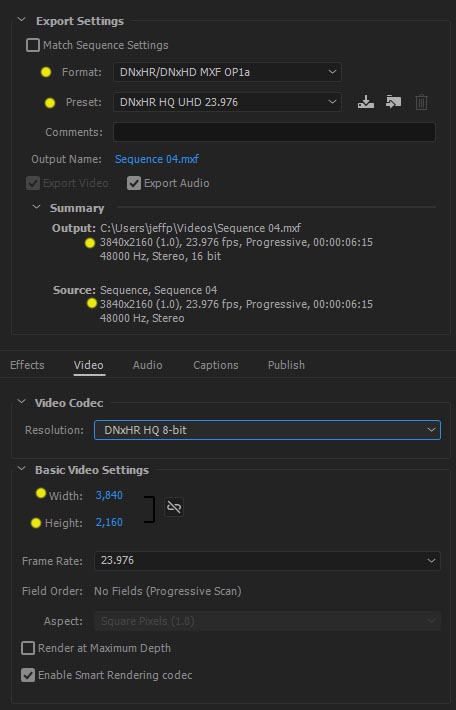Exporting Without Compression
Copy link to clipboard
Copied
I need to cut and export uncompressed MP4 footage. I would appreciate your advice.
I have around 90 minutes of footage I shot with a Sony a6300. I used the highest bit rate and resolution the camera offered. I shot at 24fps. Here are some specifications as reported by a utility called MediaInfo:
XAVC
93.3Mb/s
3840x2160 (4K)
23.976fps
AVC (High@L5.1)
(CABAC / 2 Ref Frames)
I would like to be able to cut the original files into a shorter segments without re-encoding it. I plan to transfer the segments to an external hard drive and deliver that drive to another video editor who plans to work on the files.
I have considered using the "AVI (Uncompressed)" option in the "Export Media" dialog in Premiere Pro. Is this the best available option? I've seen many "video splitter" programs in my Google searches, but I'd like to do this within Premiere if possible.
Copy link to clipboard
Copied
I'd export it as a QuickTime Format, Codec: Apple Pro Res
Here is a screenshot:

Copy link to clipboard
Copied
Prores is only on a Mac though, you could try one of the dnxhd exports.
Copy link to clipboard
Copied
Why not give editor all the material? You won't be able to chop up the files and still deliver the original XAVC codec, so you will be re-encoding (transcoding) the material to accomplish that. But you don't want an "uncompressed" format, which makes very large files for HD and gargantuan files for 4K, with NO QUALITY BENEFIT since the original footage was already quite compressed - uncompressing it does not improve quality one bit. Also, forget any ideas of delivering a cut version as .mp4, as H.264 is a lossy codec and you don't want to transcode to that for editing.
So what you want is a high-quality, near-lossless intermediate codec. For Mac, Apple ProRes was already mentioned. On PC, try DNxHR which is an Avid codec delivered as an .mxf file, or the GoPro Cineform codec is also excellent as a .mov file. In any case, KEEP the original files intact for safety! This means create a New Folder on your hard drive, and copy ENTIRE contents of SD card to that folder. Do not "pick and choose" video clips - copy it ALL since there are other folders/metadata that may be critical to recovering all footage and audio in Premiere. Use Media Browser in Premiere for the actual import.
Please note that when you transcode the footage, the resulting files might be 4x-8x larger than original clips.The up-side is that those clips will be much easier to edit since they are less-compressed, meaning the computer does much less work at "unpacking" each frame for display. Editing will be much more responsive and such, but of course editing machine must have large, fast storage to accommodate those larger files.
When looking at Sequence Settings and Export settings, you want to look for UHD at 3840x2160 to match your camera recording, as what they call 4K is actually a higher resolution of 4096x2160 which is more of the Cinema version of 4K. So when exporting/transcoding, make sure the Source and Output settings both match with 3840x2160, 1.0 pixel aspect, 23.976fps as shown below.
Note that I selected DNxHR as the Export format and it automatically chose a preset that matched my UHD 24p sequence.

To recap, if you edit your clips in Premiere, then export using ProRes or DNxHR, you will not really lose any quality at all but will end up with larger files that are easier to edit basically.
Thanks
Jeff
Copy link to clipboard
Copied
I would like to be able to cut the original files into a shorter segments without re-encoding it.
You can't. Premiere Pro doesn't offer Smart Rendering with H.264 material.
My recommendation for your situation is to export either Cineform or DNx files and hand those off to the other editor.
Copy link to clipboard
Copied
Jim_Simon wrote
My recommendation for your situation is to export either Cineform or DNx files and hand those off to the other editor.
I do too as Prores is not an option on a windows machine.
Copy link to clipboard
Copied
A very typical workflow in post-production is to simply copy the original media to drives, then deliver those drives to the other editor/colorist/fx person down the chain. Same folder structure/names, same file names. Total copy.
The next common thing is to deliver intermediate transcodes as mentioned above ... and Safeharbor11 (Jeff) has a great post on this.
Try the two and see what works.
Neil
Find more inspiration, events, and resources on the new Adobe Community
Explore Now